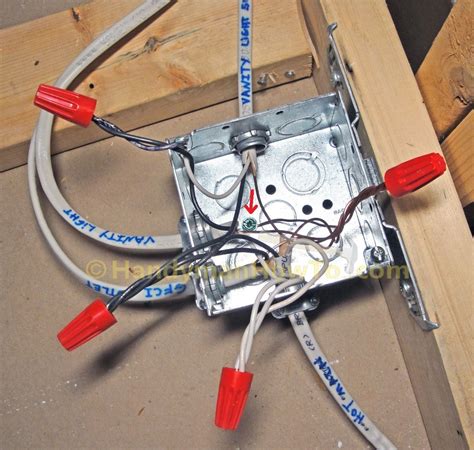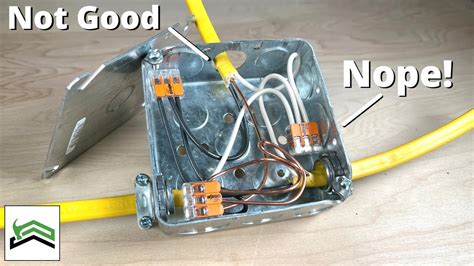electrical wiring junction box basement Learn about the dos and don'ts of installing an electrical junction box in a basement to ensure safety and compliance with electrical codes. Understand the proper techniques and common mistakes to avoid when .
Safe Deposit Boxes (type 2B) - Lambda Print Mounted to Aluminum - 2009, 2009. Save "Safe Deposit Box", and we’ll notify you when there are new listings in this category. Shop our safe .
0 · where are junction boxes located
1 · junction box wiring problems
2 · junction box screwfix
3 · home electrical junction box install
4 · electrical junction box installation instructions
5 · convert outlet to junction box
6 · 6 terminal junction box wiring
7 · 40 amp junction box screwfix
$14.95
A junction box provides a code-approved place to house wire connections, whether for outlets, switches, or splices. Here's how to install one.Eastman then demonstrates how to install a new junction box in the basement: . One essential component of DIY wiring is the junction box, a crucial element that ensures safe electrical connections. In this blog, we’ll guide you through the process of safely installing and using junction boxes, providing . Eastman then demonstrates how to install a new junction box in the basement: Choose a suitable location on the basement wall. Place the outlet against the wall and mark the screw locations. Use the hammer drill and .
Learn how to install an electrical junction box, why you might need one, and how to safely install it. What Is a Junction Box? A junction box is a standard electrical box that contains two or more spliced electrical cables. The . Learn about the dos and don'ts of installing an electrical junction box in a basement to ensure safety and compliance with electrical codes. Understand the proper techniques and common mistakes to avoid when .
The appropriate wire used for a junction box is typically an enclosed Romex wire that runs through the sub-panel or main electrical panel. This wire is commonly color-coded, .
A junction box provides a code-approved place to house wire connections, whether for outlets, switches, or splices. Here's how to install one. Junction boxes protect electrical wires from damage, prevent shocks, and stop sparks from igniting flammable material nearby. To install one, you’ll need to strip the ends off all the wires that will be in the box. To complete the electrical circuit, tie together the same-colored wires and hold them in place with wire nuts. One essential component of DIY wiring is the junction box, a crucial element that ensures safe electrical connections. In this blog, we’ll guide you through the process of safely installing and using junction boxes, providing valuable insights for DIY enthusiasts. Before starting, check with your local electrical inspector to make sure you understand specific local code requirements, and get a permit and inspection, if required. Below, I'll walk you through the basics of adding surface-mounted wiring to your garage or basement.
Eastman then demonstrates how to install a new junction box in the basement: Choose a suitable location on the basement wall. Place the outlet against the wall and mark the screw locations. Use the hammer drill and masonry bits to drill into the block wall, and use masonry screws to fasten it. Learn how to install an electrical junction box, why you might need one, and how to safely install it. What Is a Junction Box? A junction box is a standard electrical box that contains two or more spliced electrical cables. The box must have a removable, accessible cover. Junction boxes can be placed along electrical conduit, too. Learn about the dos and don'ts of installing an electrical junction box in a basement to ensure safety and compliance with electrical codes. Understand the proper techniques and common mistakes to avoid when working with electrical systems in basements. The appropriate wire used for a junction box is typically an enclosed Romex wire that runs through the sub-panel or main electrical panel. This wire is commonly color-coded, with black denoting heat, white serving as the neutral channel, and copper or green wire used for grounding the connection.
Option One: If you have an unfinished basement, you can tap into a junction box in the basement and run the cable out through the rim joist. This is even easier than tapping into a main floor outlet. Plus it allows you to put your new outlet anywhere, not .
Junction boxes, with blank covers are allowed above a suspended ceiling as it is not considered a closed space. The wires that are loose and wirenuted need to be put in a j-box. Also, clamps need to be used at each wire going into a j-box. A junction box provides a code-approved place to house wire connections, whether for outlets, switches, or splices. Here's how to install one. Junction boxes protect electrical wires from damage, prevent shocks, and stop sparks from igniting flammable material nearby. To install one, you’ll need to strip the ends off all the wires that will be in the box. To complete the electrical circuit, tie together the same-colored wires and hold them in place with wire nuts. One essential component of DIY wiring is the junction box, a crucial element that ensures safe electrical connections. In this blog, we’ll guide you through the process of safely installing and using junction boxes, providing valuable insights for DIY enthusiasts.
Before starting, check with your local electrical inspector to make sure you understand specific local code requirements, and get a permit and inspection, if required. Below, I'll walk you through the basics of adding surface-mounted wiring to your garage or basement. Eastman then demonstrates how to install a new junction box in the basement: Choose a suitable location on the basement wall. Place the outlet against the wall and mark the screw locations. Use the hammer drill and masonry bits to drill into the block wall, and use masonry screws to fasten it. Learn how to install an electrical junction box, why you might need one, and how to safely install it. What Is a Junction Box? A junction box is a standard electrical box that contains two or more spliced electrical cables. The box must have a removable, accessible cover. Junction boxes can be placed along electrical conduit, too. Learn about the dos and don'ts of installing an electrical junction box in a basement to ensure safety and compliance with electrical codes. Understand the proper techniques and common mistakes to avoid when working with electrical systems in basements.
The appropriate wire used for a junction box is typically an enclosed Romex wire that runs through the sub-panel or main electrical panel. This wire is commonly color-coded, with black denoting heat, white serving as the neutral channel, and copper or green wire used for grounding the connection. Option One: If you have an unfinished basement, you can tap into a junction box in the basement and run the cable out through the rim joist. This is even easier than tapping into a main floor outlet. Plus it allows you to put your new outlet anywhere, not .
stack-on gcdg-924 10-gun double-door steel security cabinet

where are junction boxes located
junction box wiring problems

$40.00
electrical wiring junction box basement|junction box wiring problems